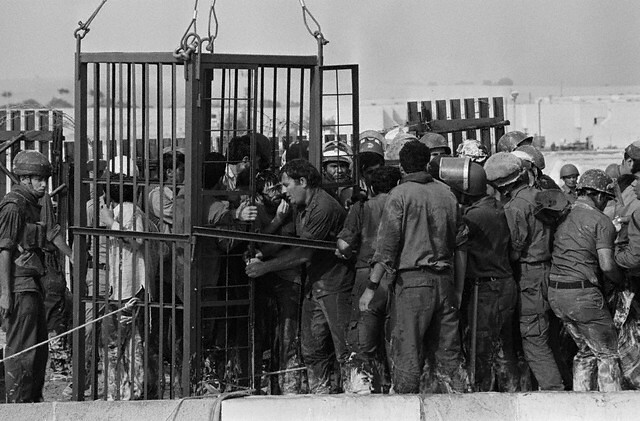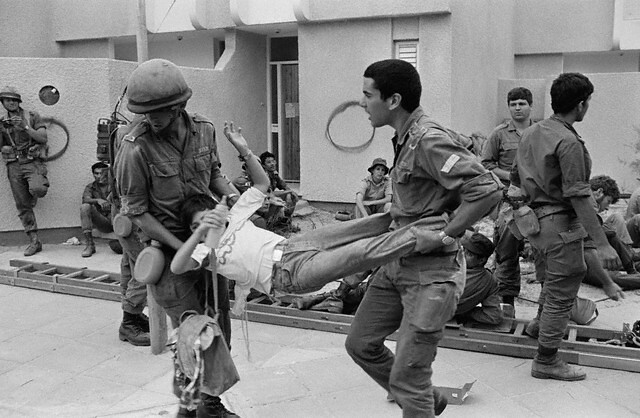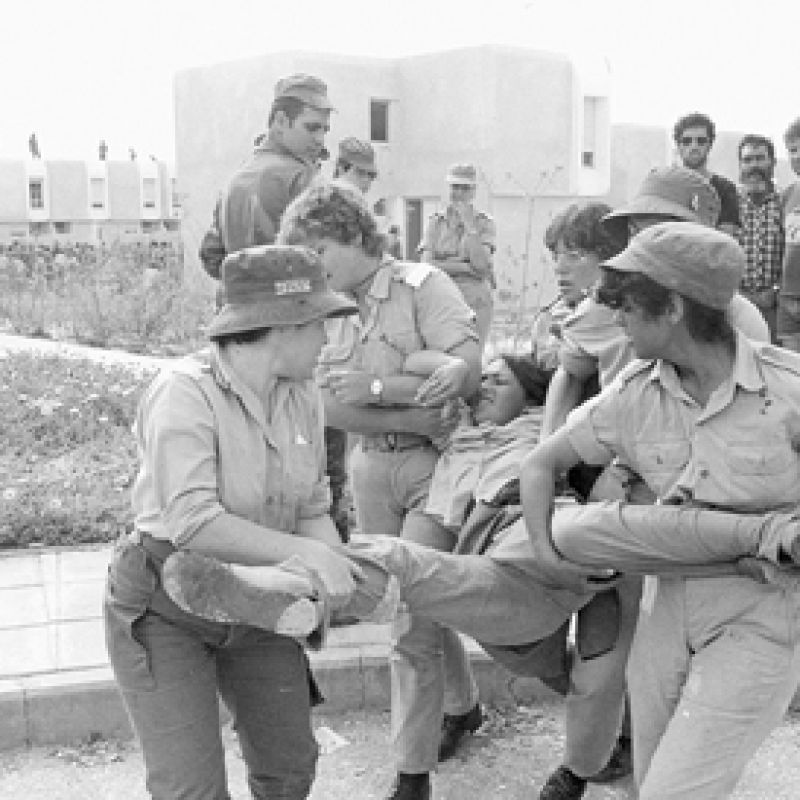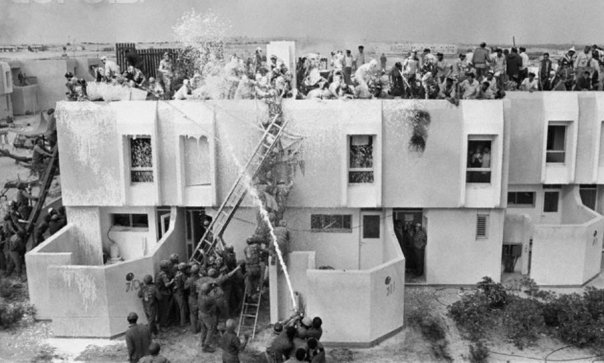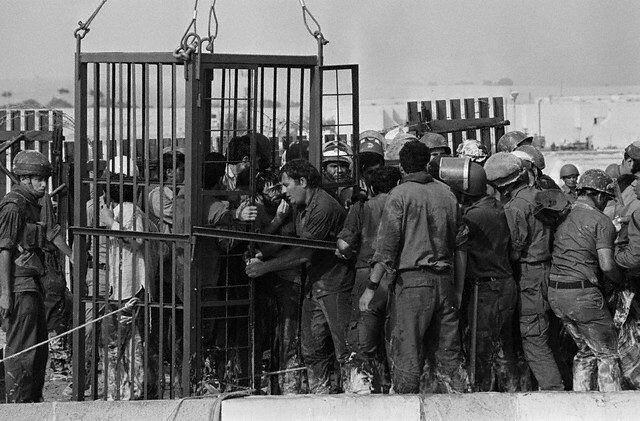Operation Dugman-5 Bet: Israeli Air Force Against Syrian Air Defense in 1973
bmpd
September 21st, 18:59
Original taken from colleague oleggranovsky in Operation Dugman-5 Bet Operation Dugman-5 Bet (referred to simply as Dugman-5 in most sources) 10/07/73 against the Syrian air defense system in the Golan Heights during the Yom Kippur War (06- 10/24/73) - one of the most unsuccessful and tragic operations in the history of the Israeli Air Force. The operation completely failed (1 S-125 air defense system was destroyed and 1 C-75 air defense system was damaged with the loss of 6 Phantoms, 10 more aircraft were damaged, 2 pilots were killed and 9 were captured), until the end of the war, the Air Force was forced to provide direct support Landfill in the absence of freedom of action in the air, which led to additional losses.
SAM S-75 (SA-2) at the time of missile launch.

A lot has been written about the operation, there are also articles on Wikipedia (quite large in Hebrew, short in English and Russian). 09/14/21 the website of the Israeli Defense Ministry "Maarahot" published an article about the operation of Major (res.) Yitzhak Steigman. The article is titled "'Dugman 5 Beth - Operation That Changed the Face of War". Steigman 1970-1990 served as Head of the Historical Research Branch (Rosh Mador Mihkar Histori) in the Air Force Heritage Branch (Anaf le-Toldot Heil ha-Avir). Author of numerous books and articles on security issues, but primarily on the Air Force during the Yom Kippur War. Steigman is currently working on a book on the subject. Below I give a retelling of this article with some of my clarifications.
PrehistoryAt the final stage of the War of Attrition, the Israeli Air Force encountered the S-125 (SA-3) air defense systems, which had recently arrived from the USSR in Egypt. There were no electronic warfare means against these air defense systems yet, the tactics of dealing with them had not been worked out. As a result, 5 Phantoms were lost in a short time, the commander of the 201st squadron Shmuel Hetz was killed.
In subsequent years, the issue of combating air defense systems was central to the Air Force. Research was carried out, funds were invested in electronic warfare, a series of experiments and exercises under the general name "Lahit" were carried out. Large-scale operations were prepared to suppress the Egyptian air defense system along the Suez Canal - "Tagar", and Syria in the Golan Heights - "Dugman". As changes in the enemy's air defense systems, on the one hand, and the strengthening of the air force on the other, the plans were clarified, their new versions and variants were released. At the start of the war, Tagar-4 and Dugman-5 Bet were relevant (ie, the Dugman plan, version 5, version 2). In general, the plans boiled down to a coordinated attack on dozens of batteries at the same time.
Understanding all the problems of the issue, the planners put forward the conditions for their implementation:
- reconnaissance data is at least 80% accurate (i.e. the coordinates of at least 80% of the enemy's air defense systems are known exactly); This was especially important for the Golan Heights, since 60% of Syrian air defense (15 batteries out of 25) consisted of mobile Kvadrat (SA-6) air defense systems; these batteries protected 3 Syrian infantry divisions on the front line and had to advance with them in the event of an attack by these divisions;
- suitable weather conditions;
- performing an operation at the beginning of the war, which was supposed to clear the way and free up funds for direct support of the ground forces in the following days.
The main force for the operations was the Phantoms, in fact, most of the fleet of these aircraft was intended to participate in the Tagar or Dugman. The plans included careful planning for the take-off of a large number of aircraft from different bases to ensure the simultaneous attack of targets, strict adherence to flight routes, widespread use of air and ground electronic warfare means, the use of long-range artillery for shelling air defense systems ( the Bendigo plan, see a separate article ), the use of UAV traps for air defense disorientation. In fact, flight commanders and individual pilots did not have the flexibility of decisions over a battlefield filled with missile launchers and massive anti-aircraft artillery (ZA) fire.
The possibility of using the Air Force for direct support of the ground forces without preliminary suppression of air defense was not predicted. This approach was brought to the attention of the NGSH and the Minister of Defense and was approved by them. However, the war began suddenly on 10/06/1973, without the Air Force being able to deliver a preemptive strike against the enemy's air defenses.
The beginning of the war and Operation Tagar-4By the night of the first day of the war (06 / 07.10.73), the command post of the high command of the IDF ("Mutsav ha-Pikud ha-Ilion") had the following picture of the situation: the situation in the Golan Heights was tolerable, along the canal - heavy. As a result, at 21:30, the Air Force Commander presented to the NGS the Air Force attack plan for the next morning: "Tagar-4". NSH approved the plan.
The plan included 4 waves of attack: the first to clear the approaches to the air defense missile system - a strike on the outside, then three attacks on the air defense missile systems themselves along the canal. The start was scheduled for 06:45 am on 07.10.73. During the night, the technicians prepared the aircraft, the pilots studied their targets. The weather along the canal was good, the coordinates of the targets were known (most of the Egyptian air defense fleet consisted of low-mobile C-75/125 complexes), so the chances of the success of the operation were good. Optimism reigned in the air force headquarters, from the next day the air force will return to full-scale hostilities according to the IDF military doctrine.
However, at night the situation in the Golan began to change. At 03:51 am, the commander of the NWO, Major General Yitzhak Hofi, informed Lieutenant General David Elazar of the NGSH that significant Syrian forces had penetrated the southern part of the Golan Heights. Urgent air support was required. This was followed by more and more new reports about the deterioration of the situation in the Golan. Defense Minister Moshe Dayan arrived at the SVO command post on Mount Knaan near Safed. After examining the situation, he tried to contact the NGSH, and without finding him, at 06:42 he called the Air Force Commander, Major General Beni Peled. Dayan said that if the air force does not begin to strike in the Golan before noon, the Syrians will break into the Jordan Valley.
At this time, the NGSh arrived at the command post of the Air Force. After a 10-minute conversation with the Air Force commander at 07:00, a decision was made: to fold Tagar-4 and go to Dugman-5 Bet. During the conversation, Peled tried to convince the NSG that the Air Force would be able to strike in the south of the Golan in parallel with the continuation of the Tagar, but after realizing that strikes were needed throughout the entire territory of the heights, he agreed. Peled notified the base commanders of the change in plans. The NGSh, however, arrived at the operational management of the General Staff, informed about the decisions and said that in an hour and a half the Air Force would begin to strike at the Golan, and in 5 hours (ie after the completion of "Dugman") air support would become massive.
At 06:57 the squadrons received an order from the Air Force headquarters: to cancel the 2nd wave of Operation Tagar and start preparing the Dugman with the strike time at 11:30. At this point, some of the aircraft were still in the air after the 1st wave of "Tagar". An urgent preparation for the operation began. It should be noted that the last aerial survey of the Golan was carried out in the morning of 10/05/1973, i.e. more than 24 hours before the start of the war and 48 hours before the start of Operation Dugman. SAM "Kvadrat" managed to move forward together with the advancing troops, thus the available intelligence is completely outdated.
Operation Forces - All 4 Phantom Squadrons (69th, 107th, 119th and 201st) and 115 Skyhawk Squadron from Tel Nof, armed with the latest A-4N aircraft with the latest by that time by the bombing system. For each squadron, its own corridor was determined in accordance with the geographical location of the bases.
Progress of Operation Dugman-5 BetAt 11:20 am, a wave of preparatory strikes on the ZA batteries and the work of electronic warfare began, and only 6 Yasur (CH-53D) helicopters were involved in the latter instead of 12 according to the plan. At 11:30, the main attack began with 64 aircraft (54 Phantoms and 10 Skyhawks).
- 13 aircraft of the 69th squadron flew from the Ramat David base to attack 6 air defense systems. All positions were empty. One of the crews, Ehud Khankin and Shaul Levi, who were flying in the 4th flight of the squadron, found their target right below them, out of the affected area. The crew tried to carry out a sharp maneuver and dive onto the battery at an angle of almost 90 degrees, but could not get out of such a dive, the plane crashed into the ground, both were killed.
- 15 aircraft of the 119th squadron from Tel Nof were also supposed to attack 6 air defense systems. They passed over the north of the Golan in the Quneitra area, and came under heavy fire from the FOR. The 2nd number in the 2nd flight, Avi Barvar and Zvi Afik, were shot down by the ZA on the way out of the attack. Both ejected and were captured.
- 17 aircraft of the 201st squadron from Hatzor were supposed to attack 3 Kvadrat air defense systems and 2 radar stations. Their flight route passed directly from west to east over the southern part of the Golan Heights, in the area of the Rapid intersection. The squadron commander at the time of the beginning of the war was abroad (as part of the delegation on the choice of a new Air Force aircraft - F-14 or F-15) and had not yet had time to return, the squadron was commanded by 1st Deputy Commander Ron Huldai (current mayor of Tel Aviv) who took office a month before. Already during the briefing, it became clear that the flight route passes over the Syrian troops wedged into the southern part of the Golan Heights, i.e. extremely problematic. However, attempts by Huldai and base commander Colonel Amos Lapidot to change the route were rejected by the Air Force's operations department: during a massive attack, re-routing threatened to thwart attacks from other squadrons. During the attack, the aircraft went close to the ground, the climb began to the east of the Rapid intersection. In this area, the convoy of the squadron's planes came under full fire from the ZA and small arms of the Syrians. Two planes were shot down before the attack. Meir Shani and Abraham Ashkhal from one plane and Haim Ram and Itzik Yahav from another ejected and were captured by the Syrians. Two more planes were shot down during the attack itself and during the exit. Ori Shahak and Gilad Gerber ejected and were captured; Kobi Hayun and Uzi Shamir were able to reach Galilee and catapulted over their territory. Eitan Levi and Yair David landed the wrecked plane in Ramat David. Immediately after them, the downed plane of Gadi Samok landed. He was alone on the plane - navigator Avikam Leaf was thrown out of the cockpit (when the plane was hit, the automatic ejection was triggered) and was captured in Syria (the only such case in the history of the Israeli Air Force, and possibly in the world). Females saw the plane of Levi and David directly in front of him, was able to take his plane to the side and avoided a collision. Thus, 4 planes of the 201st were shot down, and 2 more sat down in Ramat David. Almost a quarter of the squadron's fleet. 1 of the 4 aircraft shelters (DATAK) of the squadron was completely empty. One of the planes that returned from the attack to their base was piloted by Dan Halutz, who later became the commander of the Air Force and the OGS of the IDF (his navigator on that flight was Eran Cohen). Females saw the plane of Levi and David directly in front of him, was able to take his plane to the side and avoided a collision. Thus, 4 planes of the 201st were shot down, and 2 more sat down in Ramat David. Almost a quarter of the squadron's fleet. 1 of the 4 aircraft shelters (DATAK) of the squadron was completely empty. One of the planes that returned from the attack to their base was piloted by Dan Halutz, who later became the commander of the Air Force and the OGS of the IDF (his navigator on that flight was Eran Cohen). Females saw the plane of Levi and David directly in front of him, was able to take his plane to the side and avoided a collision. Thus, 4 planes of the 201st were shot down, and 2 more sat down in Ramat David. Almost a quarter of the squadron's fleet. 1 of the 4 aircraft shelters (DATAK) of the squadron was completely empty. One of the planes that returned from the attack to their base was piloted by Dan Halutz, who later became the commander of the Air Force and the OGS of the IDF (his navigator on that flight was Eran Cohen).
- 9 aircraft of the 107th squadron from Hatzerim flew out in 4 flights (3 pairs and three) to attack 4 air defense systems. The flight route ran over Jordan, bypassing the Syrian army. The third link, led by Ran Goren and Kobi Shmueli, managed to destroy the S-125 air defense system. As he climbed, Goren noticed that his target positions were empty. He tried to survey the area, trying to find a new position for the air defense system - to no avail. Then he remembered that on the way he had come across a C-125 battery. He turned back and bombed the battery, dropping 11 750 lb bombs on its radar and command post. In general, the aircraft of the 107th squadron had no losses.

Downed by the Phantom of the pilot Gadi Samok in Ramat David.
ResultsSo, as already mentioned at the beginning of the article, out of 25 attacked batteries (including 15 "Square"), only one was destroyed (C-125) and one was damaged (C-75). And this at the cost of the loss of 6 Phantoms, 10 more were damaged. 2 pilots were killed, 9 were captured, 2 were able to return to their own. All losses were from FORA and SV fire, plus one aircraft crashed during the attack as described above. Not a single plane was shot down or knocked out by air defense missile systems.
At the same time, immediately after the attack, based on the reports of the pilots, the Air Force headquarters was full of optimism. The head of the intelligence department, Rafi Har-Lev, believed that 36% of the 25 air defense systems (i.e. 9 air defense systems) were destroyed. Air Force Commander Peled called an even bigger figure - 17 batteries were destroyed or damaged. However, as the data was analyzed, the real picture became clear.
At the headquarters of the Air Force, at the bases and squadrons, a gloomy situation reigned. It was clear to everyone that the quick transition from Tagar to Dugman was a mistake. It was necessary to conduct aerial photography, clarify the positions of the batteries, and only then proceed to the attack. The failure created a psychological barrier in the operational department of the Air Force, until 10/18/1973 there were no new large-scale attacks on the air defense missile system. The Air Force was forced to conduct direct support of the ground forces in areas covered by the air defense system. In total, during the war, 5,143 such sorties were performed (4,044 in Egypt and 1,099 in Syria) with the loss of 60 aircraft (33 in Egypt and 27 in Syria), which amounted to 58% of the total number of losses in 103 aircraft (note that the author indicates the figure 102, but 103 is true: the difference is due to a combat aircraft of an unspecified type, which received heavy damage on 10/13/1973; the issue of its restoration was studied for a long time,for more details on Air Force losses during the war, see the web archive ). Despite the losses, the support of the Air Force was important in the battles on the Syrian front at all stages of the battles, on the Egyptian, mainly in areas where there were no air defense systems or they were already suppressed in the last days of the war.
The diagram below shows all sorties of military aircraft during the war (11,045) and their division by mission:
46.5% - direct support of SV;
37.4% - air-to-air;
6.5% - strikes against airfields;
6.4% - strikes against the air defense system;
2.2% - aerial photography;
0.9% - strikes against strategic targets.
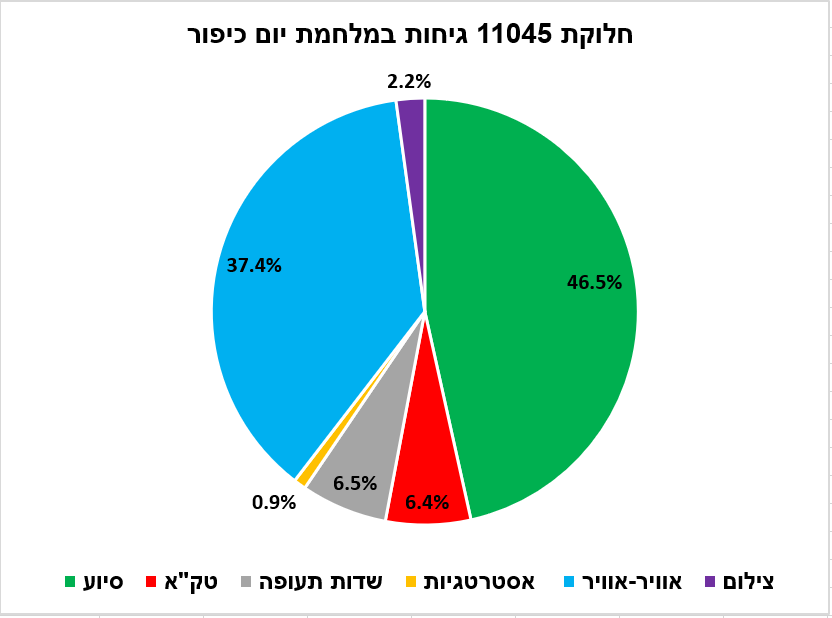
To what has been said, I will add that at the end of the war, the Air Force conducted a number of successful operations against the air defense system in Egypt. For example, during "Mefaceakh-25" on 10/22/1973, 5 air defense systems were destroyed without losses. After the war, the Air Force continued to invest strength and resources in methods of combating air defense systems, the crown of these efforts was Operation Artsav-19 in Lebanon on 09.06.82, during the First Lebanon War.
Links:
An article in the magazine "Maarakhot".
Discussion on Fresh.
https://bmpd.livejournal.com/4400220.html




















